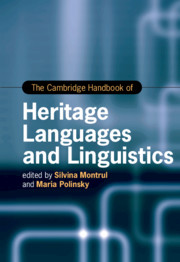Book contents
- The Cambridge Handbook of Heritage Languages and Linguistics
- Cambridge Handbooks In Language And Linguistics
- The Cambridge Handbook of Heritage Languages and Linguistics
- Copyright page
- Dedication
- Contents
- Figures and Tables
- Contributors
- Acknowledgments
- Introduction
- Part I Heritage Languages around the World
- Part II Research Approaches to Heritage Languages
- 15 Heritage Language Research and Theoretical Linguistics
- 16 The Emergence of Heritage Language
- 17 Sociolinguistic Approaches to Heritage Languages
- 18 The Psycholinguistics of Heritage Languages
- 19 Contact Linguistics and Heritage Languages
- 20 A Narrative-Ethnographic Approach to Research on Heritage Language Development
- 21 Corpus-Based Methodologies in the Study of Heritage Languages
- 22 Current Trends and Emerging Methodologies in Charting Heritage Language Grammars
- Part III Grammatical Aspects of Heritage Languages
- Part IV Heritage Language Education
- Index
- References
21 - Corpus-Based Methodologies in the Study of Heritage Languages
from Part II - Research Approaches to Heritage Languages
Published online by Cambridge University Press: 04 November 2021
- The Cambridge Handbook of Heritage Languages and Linguistics
- Cambridge Handbooks In Language And Linguistics
- The Cambridge Handbook of Heritage Languages and Linguistics
- Copyright page
- Dedication
- Contents
- Figures and Tables
- Contributors
- Acknowledgments
- Introduction
- Part I Heritage Languages around the World
- Part II Research Approaches to Heritage Languages
- 15 Heritage Language Research and Theoretical Linguistics
- 16 The Emergence of Heritage Language
- 17 Sociolinguistic Approaches to Heritage Languages
- 18 The Psycholinguistics of Heritage Languages
- 19 Contact Linguistics and Heritage Languages
- 20 A Narrative-Ethnographic Approach to Research on Heritage Language Development
- 21 Corpus-Based Methodologies in the Study of Heritage Languages
- 22 Current Trends and Emerging Methodologies in Charting Heritage Language Grammars
- Part III Grammatical Aspects of Heritage Languages
- Part IV Heritage Language Education
- Index
- References
Summary
Corpus linguistics has gained prominence in the study of language, both of standard and learner varieties, in the 1990, as technological advances allowed for quick and reliable analyses of large volumes of language data. Computer-aided analyses of large principled collections of authentic texts, known as language corpora, brought about new insights into the nature of language and afforded a more nuanced understanding of linguistic structure, language change, and language development. The chapter provides an overview of the key principles of corpus linguistics methods and of some frequently-used corpus instruments and procedures; it explores the potential benefits of application of corpus linguistics methods and instruments to the study of heritage languages, using the examples of few existing heritage language corpora. Overall, the chapter aims to engage the heritage language community in investing energy in the development of heritage language corpora and in making better use of the existing computational tools in the study of heritage languages.
Keywords
- Type
- Chapter
- Information
- The Cambridge Handbook of Heritage Languages and Linguistics , pp. 520 - 544Publisher: Cambridge University PressPrint publication year: 2021



